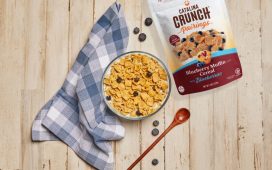CAMDEN, NJ. — The Campbell Soup Co. has reached its goal to improve fertilizer use on 70,000 acres of wheat a year ahead of schedule. In doing so, the company said it is positioned to boost farmers’ profitability, improve surrounding water quality and reduce the impact on the climate.
Campbell Soup said its plans for the fertilization optimization program date back to 2013, when the company, working alongside Walmart, made the decision to partner with wheat farmers to enroll 70,000 acres into a fertilizer optimization plan by the end of 2020.
The company identified several benefits related to improved farm practices, including:
- The production and use of nitrogen fertilizer is the largest contributor to greenhouse gas emissions from farming practices.
- Applying more nitrogen and phosphorus fertilizer than needed increases the likelihood of contaminating local watersheds or groundwater.
- Farmers can grow more at lower expense, which means they are more profitable.
As part of its plan, Campbell Soup in 2015 partnered with Environmental Defense Fund and Truterra (formerly Land O’Lakes Sustain) as they developed the Truterra farm sustainability program. According to Campbell Soup, the partnership with Truterra leverages the nationwide network of Land O’Lakes’ agricultural retailers to deploy a farm data analytics tool, called the Truterra Insights Engine, to wheat farmers alongside expert agronomy advice. The data tool also helps connect the stewardship progress metrics that are meaningful for farmers and other partners in supply chains, Campbell Soup said.
Two years later, in 2017, Campbell Soup piloted a wheat sustainability program with local agricultural retailer The Mill in the Chesapeake Bay watershed area of Maryland and Pennsylvania. That was followed by a collaboration with Heritage Cooperative to launch a similar effort for the Lake Erie watershed region of Ohio in 2019.
Campbell Soup said both the Chesapeake Bay watershed area and the Lake Erie watershed region supply wheat flour for several of its brands, including Pepperidge Farm cookies, Goldfish crackers, Snyder’s of Hanover pretzels and Lance sandwich crackers.
Originally hoping to meet its target by the end of 2020, Campbell Soup said it achieved its goal by the end of 2019 — a year ahead of schedule. The company said its partners enrolled more than 10,000 acres in Chesapeake Bay and 60,000 acres in Ohio. Campbell Soup said it has started to work with the farmers on improving fertilizer management and soil health.
“Our 70,000-acreage achievement is an important milestone for an even more ambitious goal: source 50% of our wheat flour from acres enrolled in a sustainable agriculture program by 2025,” Campbell Soup noted in a July 8 blog posting. “As we press forward, the Truterra Insights Engine is collecting multiple years of acre-by-acre data that will help us track progress in each geography and to define specific opportunities on each field.
“We’re also continuing to introduce innovations that make the Truterra tool and partnership truly best-in-class and of real value to farmers. For example, in May, Truterra announced a partnership with the National Fish and Wildlife Foundation. That partnership will integrate conservation specialists into the services at Heritage Cooperative to help farmers with even more sustainability opportunities.”
Additional information about Campbell Soup’s wheat sustainability initiative is available in the company’s 2020 Corporate Responsibility Report.






